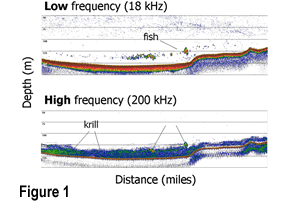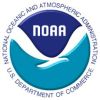|
We will study the relationship between the abundance of fish and other
animals and the position of the Bering Sea sea ice edge. Although there are major fisheries in the Bering sea, very
little is known about the distribution of fish and plankton during winter months when much of the sea is ice covered.
Previous work has shown that many fishes avoid very cold temperatures,
 and
one of the things we hope to determine is whether the area of melting
sea ice acts as a barrier for fish due to the very cold water and
less salty water in this area. Because ice cover makes it very difficult
to use fishing nets, we will use specialized equipment to measure the amount of animals in the water with sound.
These acoustic instruments (called echosounders or fish finders) work by sending pulses of sound into the
water, and then measuring the strength of the echo that is reflected back
from the animals in the water. Each species reflects sound differently
(see figure 1),
and we will distinguish echoes from fish and plankton (mostly shrimp-like krill) by looking at the way that they reflect
four different frequencies of sound. Other scientists will collect information on birds, mammals, sea temperature and
the amount of ice at the surface at the same time. Both ships on the expedition will be using acoustics to map the
distribution and abundance of fish and plankton: Healy will work primarily in the ice-covered areas, while Miller
Freeman will work in open water with no ice cover, at the ice edge, and will also enter the ice-covered waters
where possible. The information from the echosounders will be used along with the information collected by other
scientists to examine the relationships between the environment and the location of fish schools, as well as to
examine the relationships between large predators such as birds and mammals and their food. and
one of the things we hope to determine is whether the area of melting
sea ice acts as a barrier for fish due to the very cold water and
less salty water in this area. Because ice cover makes it very difficult
to use fishing nets, we will use specialized equipment to measure the amount of animals in the water with sound.
These acoustic instruments (called echosounders or fish finders) work by sending pulses of sound into the
water, and then measuring the strength of the echo that is reflected back
from the animals in the water. Each species reflects sound differently
(see figure 1),
and we will distinguish echoes from fish and plankton (mostly shrimp-like krill) by looking at the way that they reflect
four different frequencies of sound. Other scientists will collect information on birds, mammals, sea temperature and
the amount of ice at the surface at the same time. Both ships on the expedition will be using acoustics to map the
distribution and abundance of fish and plankton: Healy will work primarily in the ice-covered areas, while Miller
Freeman will work in open water with no ice cover, at the ice edge, and will also enter the ice-covered waters
where possible. The information from the echosounders will be used along with the information collected by other
scientists to examine the relationships between the environment and the location of fish schools, as well as to
examine the relationships between large predators such as birds and mammals and their food. |




